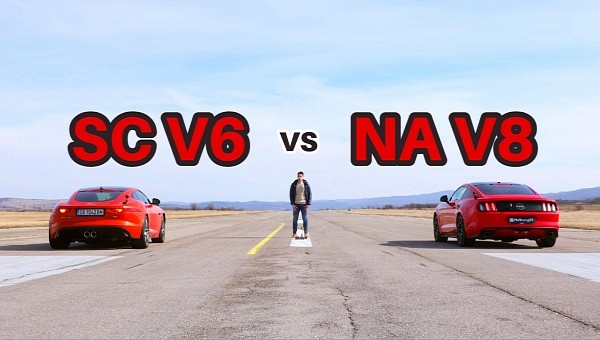Once available with a V6 powertrain, the F-Type is going the way of the dodo after the 2024 model year. There is no replacement in sight, with Jaguar currently struggling to reinvent itself as an electric vehicle brand.
In production since 2013, the Ian Callum-designed Jaguar F-Type still looks incredibly good a decade later. The V6 that Jaguar discontinued in favor of an I6 also happens to be one of the best-sounding V6s out there.
Not to be confused with the Ford Duratec-based sixer, the AJ126 V6 is rocking the same block as the AJ133 V8. The British automaker simply blanked the rearmost cylinder bores instead of loping them off, reduced the bore size of the remaining six cylinders, and redesigned the heads. Lazy or brilliant, you be the judge of that.
Pictured at ATO Aviootryad Varna in Bulgaria, the V6-powered Jag in the clip below produces a respectable 400 ps (395 horsepower) and 460 Nm (339 pound-feet) of torque from a displacement of 3.0 liters. The secret sauce is – of course – a Roots-type twin vortex supercharger mounted within the V formed by the cylinder banks.
Tipping the scales at 1,650 kilograms (3,638 pounds) or thereabout, the F-Type is equipped with one of the best – if not the very best – automatic transmissions in the business. The question is can the ZF 8HP-equipped leaping cat hold its own against a much humbler, yet more powerful and torquier opponent from the U.S. of A.?
Said opponent is a Mustang GT from the S550 generation, a pony car that makes 460 ps (454 horsepower) and 570 Nm (420 pound-feet) of torque, as per airline pilot Tseno Krastev. Those numbers aren’t correct, though, because we’re dealing with a pre-facelift model. Equipped with clear taillights, because it’s a European specification, the fastback-styled coupe from Flat Rock, Michigan actually makes 418 ps (413 horsepower) and 524 Nm (386 pound-feet) of torque.
At the beginning of the video attached below, Tseno further lists a 10-speed automatic transmission. The problem is the S550-generation Mustang didn’t receive this gearbox until the 2018 model year. The only automatic available up to 2018 was a six-speed unit.
Estimated to weigh approximately 1,700 kilograms (3,748 pounds), the pony car makes easy work of the sports car from Castle Vale in Birmingham. Not only does it launch better (props to the owner for his good reactions), but it keeps pulling strong until the quarter-mile mark. The first race concludes in 13.23 seconds at 176 kilometers per hour (around 109 miles per hour) for the Mustang, with the Jag clocking 13.32 seconds.
The second and final race is pretty much a repeat of the first. The more affordable, heavier, yet more powerful and torquier Mustang improves its time to 13.18 seconds. So does the F-Type, recording a respectable 13.24 seconds at 173 kilometers per hour (107 miles per hour).
Not to be confused with the Ford Duratec-based sixer, the AJ126 V6 is rocking the same block as the AJ133 V8. The British automaker simply blanked the rearmost cylinder bores instead of loping them off, reduced the bore size of the remaining six cylinders, and redesigned the heads. Lazy or brilliant, you be the judge of that.
Pictured at ATO Aviootryad Varna in Bulgaria, the V6-powered Jag in the clip below produces a respectable 400 ps (395 horsepower) and 460 Nm (339 pound-feet) of torque from a displacement of 3.0 liters. The secret sauce is – of course – a Roots-type twin vortex supercharger mounted within the V formed by the cylinder banks.
Tipping the scales at 1,650 kilograms (3,638 pounds) or thereabout, the F-Type is equipped with one of the best – if not the very best – automatic transmissions in the business. The question is can the ZF 8HP-equipped leaping cat hold its own against a much humbler, yet more powerful and torquier opponent from the U.S. of A.?
Said opponent is a Mustang GT from the S550 generation, a pony car that makes 460 ps (454 horsepower) and 570 Nm (420 pound-feet) of torque, as per airline pilot Tseno Krastev. Those numbers aren’t correct, though, because we’re dealing with a pre-facelift model. Equipped with clear taillights, because it’s a European specification, the fastback-styled coupe from Flat Rock, Michigan actually makes 418 ps (413 horsepower) and 524 Nm (386 pound-feet) of torque.
At the beginning of the video attached below, Tseno further lists a 10-speed automatic transmission. The problem is the S550-generation Mustang didn’t receive this gearbox until the 2018 model year. The only automatic available up to 2018 was a six-speed unit.
Estimated to weigh approximately 1,700 kilograms (3,748 pounds), the pony car makes easy work of the sports car from Castle Vale in Birmingham. Not only does it launch better (props to the owner for his good reactions), but it keeps pulling strong until the quarter-mile mark. The first race concludes in 13.23 seconds at 176 kilometers per hour (around 109 miles per hour) for the Mustang, with the Jag clocking 13.32 seconds.
The second and final race is pretty much a repeat of the first. The more affordable, heavier, yet more powerful and torquier Mustang improves its time to 13.18 seconds. So does the F-Type, recording a respectable 13.24 seconds at 173 kilometers per hour (107 miles per hour).

















